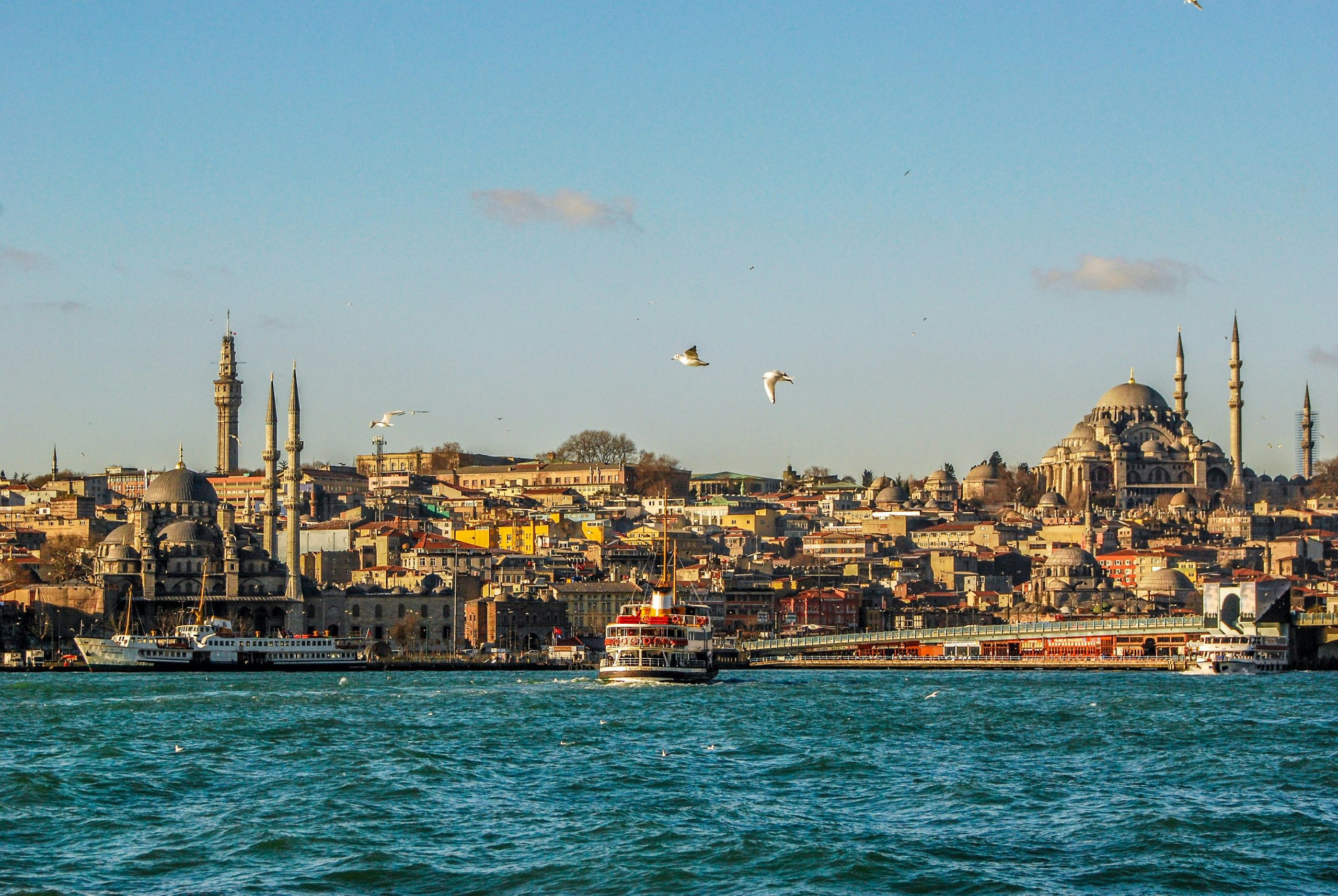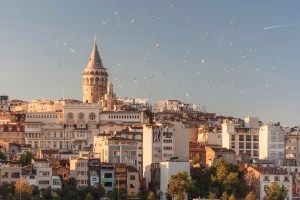Turkey, a country where East meets West, boasts an architectural landscape as rich and varied as its history.
From ancient wonders to modern marvels, the buildings in Turkey narrate tales of empires, revolutions, and artistic excellence.
Let’s explore 9 of the most iconic buildings in Turkey..
Suggested Read: How to Book a Visa Appointment for Turkey
1. Hagia Sophia (Ayasofya)

Highlights
-
Historical Wonder: Hagia Sofia was originally a Greek Orthodox church, and is now a mosque again. Hagia Sophia has served multiple roles over its 1,500-year history.
-
Mosaics and Calligraphy: Admire ancient Christian mosaics alongside Islamic calligraphy inside the structure.
-
Grand Dome: Thanks to architectural genius, the massive dome appears to float above, making it one of the most celebrated in the world.
Architecture
-
Designed by Anthemius of Tralles and Isidore of Miletus in 537 AD.
-
Features a central dome 31 meters in diameter, supported by pendentives.
-
Blends Byzantine and Ottoman architectural elements harmoniously.
Facilities
-
On-site museum shop.
-
Guided tour services.
-
Prayer areas.
Accessibility
-
Wheelchair accessible via ramps.
-
Accessible restrooms.
Costs Involved
-
Entrance: Free (for mosque access).
Location & How to Get There
-
Address: Sultan Ahmet, Ayasofya Meydanı, Fatih, İstanbul.
-
How to Get There: Take the tram to Sultanahmet Station; it’s a short walk from there.
Pro Tips
-
Visit early morning to avoid tourist crowds.
-
Dress modestly, as it’s an active mosque.
2. Topkapi Palace

Highlights
-
Imperial Residence: Home to Ottoman sultans for almost 400 years.
-
Sacred Relics: Houses relics of the Prophet Muhammad and other religious artifacts.
-
Harem Section: Intricately decorated private quarters of the sultans.
Architecture
-
The Topkapi Palace was built in 1478 by Sultan Mehmed II.
-
Traditional Ottoman architecture with sprawling courtyards.
-
The complex includes dozens of smaller buildings and gardens.
Facilities
-
Museum cafes and gift shops.
-
Audio guide services.
-
Rest areas in courtyards.
Accessibility
-
Wheelchair-accessible entrances.
-
Free entry for visitors with disabilities.
Costs Involved
-
Entrance fee: ~750 Turkish Lira (subject to change).
-
The harem section requires an additional ticket.
Location & How to Get There
-
Address: Cankurtaran, 34122 Fatih/İstanbul.
-
How to Get There: Tram to Sultanahmet Station.
Pro Tips
-
Buy a museum pass to save money if visiting multiple sites.
Suggested Read: Nightlife In Turkey
3. Dolmabahçe Palace

Source: https://en.wikipedia.org/wiki/Dolmabah%C3%A7e_Palace
Highlights
-
European Elegance: A stark contrast to Topkapi’s Ottoman style.
-
Crystal Staircase: Featuring Baccarat crystal and marble.
-
Clock Tower: A picturesque addition near the entrance.
Architecture
-
Designed by Garabet Balyan in 1856.
-
Neoclassical, Baroque, and Rococo influences.
Facilities
-
Guided tours.
-
On-site cafes.
-
Photography is permitted outside.
Accessibility
-
Accessible ramps.
-
Mobility scooters are available for rent.
Costs Involved
-
Entrance: 650 Turkish Lira for full access.
Location & How to Get There
-
Address: Vişnezade, Dolmabahçe Cd., Beşiktaş, İstanbul.
-
How to Get There: Ferry to Kabataş, then walk.
Pro Tips
-
No photography is allowed inside the palace rooms.
4. Galata Tower

Highlights
-
Panoramic Views: 360-degree views of Istanbul.
-
Historical Museum: Exhibits about Istanbul’s medieval history.
-
Café at the Top: Enjoy Turkish coffee with a view.
Architecture
-
Built by Genoese colonists in 1348.
-
Conical cap and cylindrical tower body.
Facilities
-
Elevators up to the viewing platform.
-
Restaurant and café on-site.
Accessibility
-
Elevator to most floors; some steps still required.
Costs Involved
-
Entrance: ~650 Turkish Lira.
Location & How to Get There
-
Address: Bereketzade, Galata Kulesi, Beyoğlu, İstanbul.
-
How to Get There: Walk from Karaköy Tram Station.
Pro Tips
-
Sunset is the best time for photography.
5. Cappadocia Cave Houses

Highlights
-
Unique Accommodations: Sleep inside ancient volcanic formations.
-
Hot Air Balloon Views: Stunning sunrises over fairy chimneys.
-
Rock-cut Churches: Visit Göreme Open Air Museum.
Architecture
-
Natural tuff rock formations adapted into dwellings.
-
Dating back to Byzantine times.
Facilities
-
Boutique hotels with spa services.
-
Rooftop breakfast areas.
Accessibility
-
Some cave hotels are not accessible due to rugged terrain.
Costs Involved
-
Nightly stays from 2000 Turkish Lira onwards.
Location & How to Get There
-
Address: Cappadocia region (Göreme, Ürgüp, Avanos).
-
How to Get There: Domestic flight to Nevşehir or Kayseri airport, followed by a short drive.
Pro Tips
-
Book early for hot air balloon rides.
Suggested Read: Museums in Turkey You Must Visit At Least Once in Your Lifetime
6. Ephesus Celsus Library

Source: https://simple.wikipedia.org/wiki/Library_of_Celsus
Highlights
-
Ancient Roman Marvel: Once the third-largest library in the ancient world.
-
Photogenic Ruins: Columns, statues, and the facade are largely intact.
-
Historical Tours: Guided walks through Ephesus ruins.
Architecture
-
Built in 117 AD.
-
Facade with Corinthian-style columns and intricate sculptures.
Facilities
-
Ticket booths.
-
The souvenir stands nearby.
Accessibility
-
Partially accessible with ramps.
Costs Involved
-
Entry: ~700 Turkish Lira.
Location & How to Get There
-
Address: Selçuk, İzmir Province.
-
How to Get There: Train from Izmir or private car.
Pro Tips
-
Wear comfortable shoes for walking on ancient stones.
7. Grand Bazaar (Kapalıçarşı)

Highlights
-
Shopping Paradise: Over 4,000 shops inside.
-
Historic Atmosphere: Dates back to the 15th century.
-
Artisan Goods: Carpets, jewelry, spices, and antiques.
Architecture
-
Built in 1455 by order of Sultan Mehmed II.
-
Maze-like structure with vaulted ceilings and domes.
Facilities
-
Food courts and cafés.
-
Currency exchange and ATMs.
Accessibility
-
Wide alleys, but can get crowded.
Costs Involved
-
Free to enter; bargain hard while shopping.
Location & How to Get There
-
Address: Beyazıt, Fatih, İstanbul.
-
How to Get There: Tram to Beyazıt-Kapalıçarşı Station.
Pro Tips
-
Always negotiate prices by at least 30%.
Suggested Read: 18 Best Festivals in Turkey You Must Experience
8. Antalya Old Town (Kaleiçi)

Highlights
-
Charming Streets: Ottoman-era houses and Roman towers.
-
Hadrian’s Gate: Historic entrance to the city.
-
Marina Views: Beautiful harbor, perfect for a sunset walk.
Architecture
-
Mixture of Roman, Byzantine, Seljuk, and Ottoman designs.
Facilities
-
Boutique hotels.
-
Numerous cafes and restaurants.
Accessibility
-
Cobbled streets may be tricky for wheelchairs.
Costs Involved
-
Free to explore.
Location & How to Get There
-
Address: Kaleiçi, Antalya.
-
How to Get There: Bus or tram to Old Town (Kaleiçi).
Pro Tips
-
Best explored on foot; wear comfy shoes.
9. Sumela Monastery
Highlights
-
Cliffside Wonder: Perched dramatically on a cliff face.
-
Religious Art: Frescoes dating back to the Byzantine period.
-
Scenic Forest Trails: Beautiful hikes through the Altındere Valley.
Architecture
-
Founded in 386 AD.
-
Greek Orthodox design is embedded into the cliff.
Facilities
-
Visitor center and restrooms.
Accessibility
-
Challenging hike; not recommended for those with mobility issues.
Costs Involved
-
Entry: ~300 Turkish Lira.
Location & How to Get There
-
Address: Altındere Valley, Trabzon Province.
-
How to Get There: Bus or taxi from the Trabzon city center.
Pro Tips
-
Carry water and wear hiking shoes.


FAQs About Buildings in Turkey
1. What is the oldest building in Turkey?
The oldest known structure is Göbekli Tepe, dating back to 9600 BC, located in Şanlıurfa Province.
2. Is Hagia Sophia still considered one of the iconic buildings in Turkey?
Yes, Hagia Sophia remains one of the most iconic and historically significant buildings in Turkey, now functioning as a mosque after serving as a church and a museum.
3. Do I need a ticket to visit religious buildings in Turkey, like the Blue Mosque?
No, many religious buildings in Turkey, like the Blue Mosque, offer free entry, although respectful donations are often welcomed.
4. Are modern buildings in Turkey built to withstand earthquakes?
Yes, modern buildings in Turkey are constructed following strict earthquake-resistant standards, due to the country’s seismic activity.
5. What is the best time to visit historical buildings in Turkey?
The best time to explore historical buildings in Turkey is during spring (April-May) and autumn (September-October) when the weather is mild and pleasant.
6. Can I book guided tours for exploring places like Cappadocia’s cave houses or Pamukkale?
Many local agencies offer guided tours to help visitors discover the most famous buildings in Turkey, including Cappadocia’s cave dwellings and Pamukkale’s ancient ruins.


















